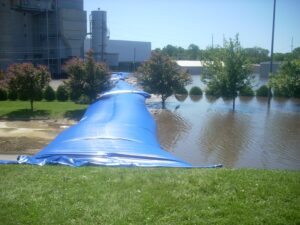Hurricanes are one of the most destructive natural calamities on earth. They are severe tropical storms that often bring about catastrophic damage to homes, infrastructure, and other properties. One of the most devastating consequences hurricanes can produce is flooding. The flooding that results from hurricanes can lead to loss of lives, displacement of people, and severe economic damage. Below, we’ll discuss how hurricanes can lead to floods, their risks, and how you can prepare for them.


What is a hurricane?
A hurricane is a severe storm that originates from the Atlantic Ocean and mostly moves to the west or northwest. The storm can be as wide as 600 km and last for weeks. The most significant danger related to a hurricane is flooding. Flooding occurs when an over-abundance of water is displaced onto land, resulting in a massive inundation that can cause profound harm to homes, infrastructure, and other properties.
Climate Change and Hurricane Flooding
With climate change, we are seeing an increase in the number and intensity of hurricanes, which can be a dangerous combination. Experts predict that the Atlantic hurricane season could see as many as 13 to 19 named storms on average this season. As such, it is crucial to recognize the role of climate change and take steps to reduce its impact. By reducing greenhouse gas emissions, we can reduce the likelihood of severe hurricanes and, therefore, reduce the associated flooding risks.
What are the flood risks associated with hurricanes?
The floods that occur during hurricanes are the most severe due to several factors. The hurricanes get water from the ocean, which is often warm and humid, helping generate the circulation of winds. The hurricanes move slowly and deposit vast amounts of rainfall. As a result, hurricane-prone areas like Florida, the Gulf of Mexico, or North Carolina can face flood threats for days during each storm. The winds from a hurricane and the tidal surge that accompanies these high winds often result in wall-like floods that overflow banks and flood coastal regions and low-lying areas. According to experts, the risks to coastal communities are increasing, with many experts predicting that sea levels will rise within the next few decades.


How can you prepare for a hurricane’s flood risks?
Preparation is crucial if you live in a hurricane-prone area. You should ensure that you have adequate supplies to survive in case of flooding during a hurricane. These preparations should include the following:
1. Create an emergency kit: Assemble an emergency kit to last at least 72 hours. This kit should include non-perishable foods, a flashlight, fresh water, extra batteries, important documents (ID, insurance papers, etc.), a first aid kit, and any medication you need.
2. Protect your home: Take necessary precautions to ensure your home does not flood. These precautions should include installing flood barriers, cleaning drains and gutters, moving belongings to elevated places if possible, and waterproofing your basement if you have one. Homeowners can also protect their homes from flooding during a hurricane with special additions, such as fortified windows, doors, and roofs. You can also work with municipal authorities to develop emergency response plans for when flooding occurs.
3. Have a personal evacuation plan: If the threat of the hurricane seems great, make an evacuation plan. This should include where you will go if you evacuate, how you will get there, and who you will go with.
4. Stay updated: Stay informed about what is happening in your area through modern forms of communication like radio, TV, or your cell phone. Make sure you understand weather bulletins, know the right authorities to contact, and have up-to-date hurricane maps. It is crucial to be aware of the risk of flooding when there is a hurricane. Also, you need to check your area to find out if you live in a flood-prone zone. If you do live in a flood-prone zone, you should pay careful attention to the weather report and take necessary precautions.


The following are critical things to do during a flood:
– Stay away from areas that are prone to flooding or ordinarily flood from flash rain. These areas include creeks, streams, canals, and similar spots. – Do not drive through floodwaters, as it is uncertain how deep the water may be. – Keep alert and listen to weather reports to know when the rain might cease and if there is a flood watch or warning. – Stay indoors until a storm has passed and wait for instructions from local authorities before stepping out.
Hurricanes and the associated flooding risks are a harsh reality that we have to navigate. It is possible to mitigate the risks by being prepared and honing emergency response plans, both at the individual and community levels. With the occurrence of more severe hurricanes predicted due to climate change, it’s even more critical to act now to reduce our impact. That way, we can protect ourselves and our communities and minimize the damage caused by hurricanes and the associated risks of flooding.
Preparing for hurricane season means ensuring that your business or property is protected against the worst-case scenario. For the past 26 years, we’ve been the number 1 provider of temporary flood protection, damming, and dewatering solutions worldwide. Our cofferdams are offered in a wide selection of working heights and lengths to provide you with the highest level of protection available. This fact is just one of the reasons we’re trusted worldwide to ensure properties stay dry and protected. Want to learn more? Contact us at any time, or come see us in person at our world headquarters in Waller, Texas!


